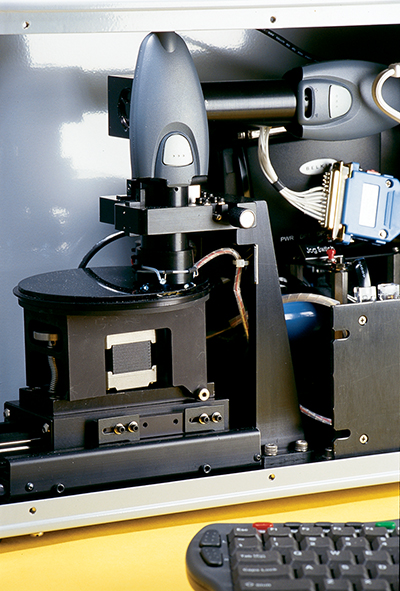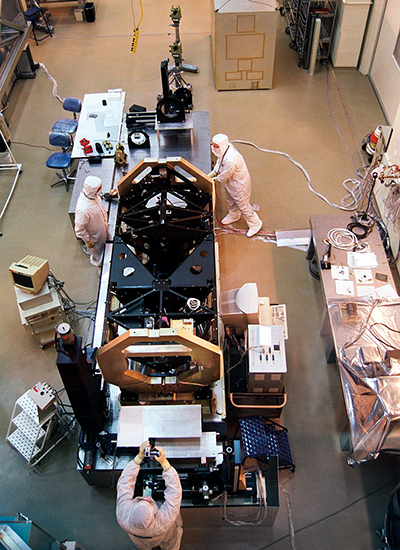An IDEA of What's in the Air
People with allergies know that particles in the air can have a major impact on their health. Particles can create problems for sensitive mechanical equipment as well, especially in cases where payload components must be kept in clean rooms. While clean rooms do protect this equipment, particle fallout contamination is still a major concern of NASA and aerospace-related industries. Depending upon the type and size of the particles, fallout can affect the performance of sensitive spaceborne instruments and support equipment. Because of this, contamination must be measured regularly to ensure equipment safety and reliability.
The Aerospace Engineering Group of IDEA, LLC, in Ellicott City, Maryland, has commercialized the Automatic Particle Fallout Monitor (APFM) in response to the need for a faster and completely automated instrument that can efficiently assess real-time particle contamination levels in a facility. IDEA's accomplishment grew from a partnership with NASA's Kennedy Space Center whose engineers developed the APFM, a detection instrument that directly images, sizes, and counts contamination particles. After Kennedy field tested the APFM, the Research Triangle Institute (RTI) assisted NASA with finding an industry partner interested in commercializing it. RTI, an organization devoted to the transfer of NASA technology, brought in IDEA and several other companies for briefings about the APFM. Through a competitive process, IDEA won a dual-use contract with Kennedy, giving it license rights to the NASA-patented prototype. IDEA was tasked with optimizing and commercializing the APFM system by easing the manufacturing process, validating the system's performance, and assessing market potential. This resulted in a commercial product for IDEA that also fulfills Kennedy's needs.
Traditionally, particle fallout contamination levels in a facility are measured by placing a collection plate, known as a witness plate, in a specific area. After several weeks, the witness plate is transported to a laboratory where personnel manually count the particles under a microscope. IDEA's APFM provides an alternative to this method by directly counting the number of particles which collect on a witness disk, similar to a witness plate, inside the instrument. The monitor automatically measures the size and density of particles that collect on the surfaces of the room in which it is placed. The APFM, which has National Institute of Standards and Technology (NIST) traceable calibration, can measure particles as small as 1 micrometer in diameter and can differentiate between fiber-shaped and circular-shaped particles. The instrument provides a quantitative measurement of the cleanliness of a room according to Military Specification (Mil Spec) 1246 standards and provides real-time data within 4.3 hours of deployment, making it the most advanced and fastest quantitative system on the market to date.
The APFM consists of a computer processor, a sensor head assembly, and custom application software. The processor analyzes images, archives them, and sizes and counts particle data. It also controls the positioning of the witness disk under the sensor heads. The two sensor heads image the accumulated particles on the witness disk. The two stepper motors rotate and shift the witness disk into position under the two cameras. One camera images small particles while the other images large particles. The images are then sent to the processor, which counts and sizes the particles in each image. The processor is a fully functional personal computer with customized application software and a graphical user interface, making it a specialized instrumentation controller. The software offers a user-friendly monitoring, control, and command display capability that allows for easy maintenance, calibration checks, and change-out of witness disks.
The APFM allows personnel to respond to particle contamination before it becomes a major problem. In NASA's case, the APFM improves the ability to mitigate, avoid, and explain mission-compromising incidents of contamination occurring during payload processing, launch vehicle ground processing, and potentially, during flight operations. Commercial applications can be found in semiconductor processing and electronics fabrication, as well as in aerospace, aeronautical, and medical industries. The product could also be used to measure the air quality of hotels, apartment complexes, and corporate buildings. IDEA sold and delivered its first four units to the United Space Alliance for the Space Shuttle Program at Kennedy. NASA used the APFM in the Kennedy Space Station Processing Facility to monitor contamination levels during the assembly of International Space Station components.

A collection disk is mounted below a video camera, which scans the disk’s surface to detect particles. The disk rotates under the camera, which has two magnification levels.

The Automatic Particle Fallout Monitor is used in clean room environments where satellites are assembled.













